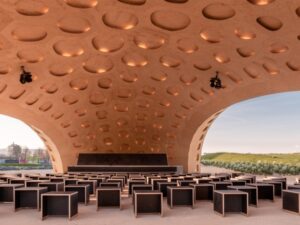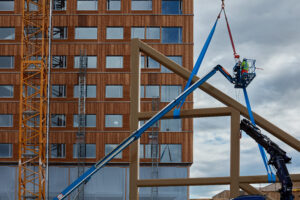A revolution has taken place in the construction industry: the development of mass timber, the technical term for industrial timber. It allows for the construction of innovative buildings. Mass timber as a construction material can now even outperform bricks, concrete and steel in terms of cost, sustainability and wellbeing.
MaterialDistrict, a Dutch foundation, has published Tomorrow’s timber, a book that explores all aspects of building with timber, from GHG emissions and fire resistance to design and costs. This is the second of two articles.

Mass timber buildings
Traditional timber buildings were made from many small linear timber elements. Many mass timber buildings on the other hand feature large engineered structural wood panels and beams made from multiple layers. This improves their performance in terms of structure, fire safety, acoustics, seismic resistance etc. Mass timber has the potential to substitute steel and concrete in structural applications. This opens up new mass markets for timber, including high-rise buildings.
The book discusses at some length mass timber technologies. One of the most widely used techniques results in glue laminated timber (glulam). This consists of several softwood boards, glued together with parallel fibres. Pieces with knots and other small defects are removed, which results in a strong beam. As each of the rather thin boards can be bent, glulam may be used to produced curved forms. The beams look somewhat like solid wooden beams, but they are stronger and can be made very long, up to 80 metres. Another widely used product is cross laminated timber. Here, the fibres are glued in perpendicular directions. The material is very well suited for the production of large flat surfaces like floors.

Occupants’ wellbeing
There are many variations to these techniques, each resulting in a material suited for particular purposes. Wooden elements may vary in thickness, or they may be veneered for their appearance. Wood industry has also developed many kinds of boards from chips and sawdust resulting from its operations. Moreover, we can treat solid wood in order to increase its durability. With such treatments, softwood will get many of the properties of hardwood. Among these techniques are treatment with acetic anhydride under pressure (acetylation). Or with furfuryl alcohol, a side product of cane sugar production (furfurylation). Or just by heat treatment.
Mass timber requires new design approaches. And it facilitates them. The book is full of photos of wonderful buildings. Timber’s light weight carries specific advantages, like better thermal insulation. But the same property is challenging for acoustics. Timber has the benefit of low thermal conductivity, much lower than that of concrete. And mass timber buildings ‘breathe’ much more than concrete buildings, which contributes to an agreeable general atmosphere. But this section of the book ends with the remark that more research is required. Are there any cultural and regional differences in the experience of such wellbeing? Do different age groups react differently to wooden constructions?
Building process
New structural properties may also result in new construction processes. This is the area where timber construction should outperform traditional building methods, as the materials by themselves are more expensive. More than in traditional construction, planning is of great importance. The project team needs to have experience in mass timber construction. Large parts of the building need to be prefabricated. Logistics need to be smart, tailored to just-in-time arrival of structural elements. Work needs to be precise: airtightness, acoustics and low vibration can only be up to par if the work onsite is performed with much precision.
Mass timber constructions offer advantages if many elements can be prefabricated, i.e. in mass construction projects. Or where lightweight is an advantage, like on a building site with poor soil conditions or on topping-up an existing building. On the other hand, mass timber construction may also be very well suited for very complex buildings. This is because glulam beams can be bent into any form; to be done in combination with 3D modelling.
Sustainability and health
Some developments in society may promote mass timber construction. Society tends to value sustainability and health. Timber is a biobased material; and it offers the opportunity for reuse of the building’s elements after disassembly. There is also evidence that timber exposure in the interior has direct health benefits. The technology is still in its infancy, relatively speaking; it can become more industrialized (better, cheaper) in the future. Finally, we should take into account that the world faces an increased urbanization. Constructing our cities in mass timber will allow us to combine this with GHG reductions – not so if we should continue building them in concrete. And timber offers more opportunities for densification of urban areas, for instance by topping up existing buildings, or by using the space above rails and roads.
At present, the economic benefits of building in timber may not seem to be decisive. But then, the authors conclude, we haven’t taken into account the monetary value of timber’s environmental benefits. It may not be long before countries will start to tax carbon emissions; that will be a major incentive for timber constructions. And even without these incentives, there are large-scale developments in mass timber that pop up world-wide. ‘The 21st century may very well become the Second Timber Age, a beautiful and healthy pathway towards a low-carbon, healthy economy.’
Interesting? Then also read:
Sustainable materials need certification and lobbies
Mycelium as a construction material
Bamboo, a promising feedstock
